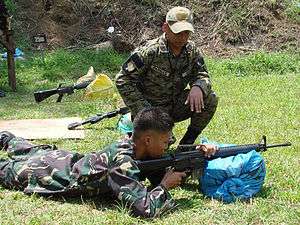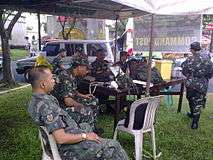Philippine Army Reserve Command
| Army Reserve Command Pangasiwaan ng Panlaáng Kawal ng Hukbóng Katihan Comando de la Reserva del Ejército | |
|---|---|
.png) Coat of Arms of the Army Reserve Command | |
| Active |
September 1, 1977 – February 26, 1986 May 12, 1992 – present |
| Country |
|
| Allegiance |
|
| Branch | Philippine Army |
| Type |
|
| Role | Conventional and Unconventional Warfare, Anti-Guerrilla Operations, Combat Support & Service Support, Force Multiplier, Training, Disaster Rescue & Relief, and Community Service |
| Size | 40,000 |
| Part of | Under the Philippine Army |
| Garrison/HQ |
Camp General Mariano Riego de Dios, Tanza, Cavite |
| Nickname(s) | ARESCOM, RESCOM |
| Motto(s) |
Committed citizen army builder Una compromiso constructor de un ejecito ciudadano |
| Anniversaries | May 12 |
| Decorations |
Philippine Republic Presidential Unit Citation Badge |
| Commanders | |
| Commander-in-Chief | President Rodrigo Roa Duterte |
| Secretary of National Defense | Delfin Lorenzana |
| Chief of Staff |
|
| Commanding General of the Philippine Army |
|
| ARESCOM Commander |
|
| Notable commanders |
|
| Insignia | |
| Unit Patch (photo: Hernan Bustelo) |
 ARESCOM uniform patch. |
The Army Reserve Command (ARESCOM or RESCOM; Filipino: Pangasiwaan ng Panlaáng Kawal ng Hukbóng Katihan or PPKHK) is a Major Support Command of the Philippine Army. It was created for the sole purpose of Reserve Force management, organization and Government Arsenal procurement.
History
Col Pascual Luis D Bedia CAV MNSA (GSC) PA is the incumbent Commander of ARESCOM. He assumed his post effective 1 February 2016 after the compulsory retirement of BGEN MICIANO AFP (RET).



Pre-Colonial period
The utilization and management of Reserve Forces in the Philippines started when Rajah Lapu-Lapu, chieftain of the Mactan Island, Cebu, rallied his troops and defeated the Spanish invaders led by Fernando Magallanes in the year 1521. Due to his actions as the local village chief, Rajah Lapu-lapu and his townsfolk became the very first reservists that saw action in defending the Philippines.[1][2]
Philippine Commonwealth
By 1935, the Philippine Commonwealth, under the leadership of President Manuel Luis Quezon enacted the very first legislature of his government. Commonwealth Act Nr. 01 ensured that Philippines will be prepared to thwart off any invasion or aggression of some sort by any nation, or entity and thus called upon its citizens to provide manpower to then fledgling Philippine Army. The National Defense Act of 1935 heralded the creation of what would be the Armed Forces of the Philippines and very first documented account of voluntary citizen enlistment.[3][4]
World War II
Reservists fought hard during the 1940s and saw action on almost all parts of the country in World War II. Regular and reserve members of then Philippine Army/Philippine Army Air Corps (forerunner of the Phil Air Force), the Philippine Constabulary, and the Philippine Offshore Patrol (what would become the Phil Navy later on.) were incorporated with US units and rallied under the banner of the USAFFE.[1]
A ragtag group of former ROTC Cadets, Guerilla Fighters and draftees of the Philippine Army Reserve Force formed units among themselves and fought gallantly against the Japanese invaders. Collectively, they were known as the Hunters ROTC Unit.[5]
Post World War II
Post WWII saw the re-organization of the AFP and the further need to rebuild the defense of the nation. Reserve units were then organized to Battalion Combat Teams with the sole purpose of force augmentation in the eventuality that another world war ensues.[4]
On September 1, 1977, the Army Reserve Command was activated pursuant to General Orders No. 250 of the Philippine Army. Army officers were tasked to organized, train, and manage a reserve force that will equate or surpass the current strength of its regular forces.[1]
1986 EDSA Revolution
By 1986, after the infamous EDSA Revolution, the unit was shortly deactivated since the AFP at that time will undergo retraining and re-organization.
Birth of the modern reserve force
1991 saw the birth of a new reserve force when Republic Act 7077 (Reservists Act of 1991) was signed into law on July 1, 1991. This new legislation directed the AFP to organize and create units with the sole purpose of reservists management.[4]
On May 12, 1992, the Reserve Command, Philippine Army, was again reactivated pursuant to HPA General Orders No. 392 and was later again renamed as the Army Reserve Command on October 1, 1999 (HPA GO Nr 1300) and was given its marching orders to maintain, administer, develop, train, and organize reservists units to help enhance and sustain National Security and Development.[1]
Future of the reserve force
In the 21st century, the unit is modernizing itself pursuant to the directives of Headquarters, Philippine Army's transformation roadmap to 2028.[6][7]
Legal mandate
Commonwealth Act 1
Commonwealth Act No. 1, particularly Section II, cites the responsibility of each and every citizen of for the defense of the nation. Citizens may be mobilized in the event the national government declares an act of war or emergency.[8]
Republic Act 7077
Republic Act No. 7077,[10] also known as the Citizen's Armed Force Act or Reservist Law of 1991, is an act passed in to law by the joint house of representatives which clearly provides the policies and procedures in the creation and administration of reservists and reserve units of the Armed Forces of the Philippines.
Republic Act 9163
Republic Act No. 9163,[11] also known as the National Service Training Program Act or National Service Law of 2002, defines the policies and procedures in administration/training of ROTC Units in relation to the other two (2) components, Civic Welfare Training Service (CWTS) and Literacy Training Service (LTS), of the National Service Training Program (NSTP).
Role of women in the reserve force
Section 65, Article X, of RA 7077 clearly defines the right and duty of every able bodied female citizen of the Republic of the Philippines to serve in the Armed Forces of the Philippines. Standards for acceptance of female reservists shall likewise be kept standard like their male counterparts with a few adjustments due to physiological differences with the later.[12]
Commissioned officers











Non-commissioned officers




Training
Training is the major task handled by ARESCOM. Its primary arms are the university/college-based Department of Military Science and Tactics-administered mandatory basic and the optional advanced Reserve Officer Training Corps (ROTC);[23] and the territorial unit-administered Basic Citizen's Military Training (BCMT).
Reserve Officer's Training Corps (ROTC)

Basic ROTC is the only component required by a tertiary (college) level student to have completed as requirement for completion of the National Service Training Program. Military subjects are provided similar to how military instructions are conducted in the service academies and graduates are automatically enlisted in the reserve force of the particular service branch (Army) administering the training. Advance ROTC is purely voluntary in nature and that Advance ROTC Cadets are provided a modest allowance after passing the requirements for their respective Advance ROTC Examination (PAARE). Completion of Advance ROTC is considered a graduate qualification in Military Science, and such graduates who subsequently progress to the Probationary Officer Training Course (POTC)[24] are commissioned as 2nd Lieutenants.[23]
Other than time-in-grade and merit promotions, rank adjustments are authorised depending on civilian qualifications, as well as their reciprocity to the operating environment.[25]
Basic Citizen's Military Training (BCMT)

Basic Citizen's Military Training (BCMT) is a military training course conducted by the Philippine Army through the Army Reserve Command. It is an entry level training course undertaken by Filipino Citizens wanting to enlist in the reserve force.
BCMT instruction is administered by a joint training pool of military instructors from both regular and reserve forces and is usually conducted inside any of the Philippine Army's training camps. Guest instructors are requested from other government agencies and non-government organizations (NGO) for specialized instructions.
Special Basic Citizen's Military Training (SBCMT) is a special course conducted by the Philippine Army in response to a request from a Local Government Unit (LGU). Funding is usually provided for by the requesting agency as compared to regular BCMT which receives funding from the Army.
Types of reservists
There are currently two types of reservists in the Armed Forces of the Philippines (AFP) Reserve Force:[12][26]
Categorization of reservists and reserve units
Section 12, Article 5, of Republic Act 7077 breaks down and categorizes reservists and their units based on various criteria cited by this law.[12]
- First Category Reservists - Able bodied reservists aged eighteen (18) years of age up to thirty five (35) years of age, inclusive.
- Second Category Reservists - Able bodied reservists aged thirty six (36) years of age up to fifty one (51) years of age, inclusive.
- Third Category Reservists - All able bodied reservists aged above fifty (51) years of age.
Classification of reservists and reserve units
Section 13, Article 5, of Republic Act 7077 clearly cites the classification of reservists based on their operational readiness for immediate deployment or mobilization.[12]
- Ready Reserve - physically-fit and tactically-current reservist personnel that are always on constant alert and training; ready to mobilize once a mobilization order has been given.
- Standby Reserve - reservist personnel who do not maintain currency in specialization qualifications but the base for expansion, support and augmentation to the Ready Reserve Force as needed.
- Retired Reserve - composed of citizens who are qualified for retirement either by length of service or age.
Lineage of commanding officers
Commanders of ARESCOM are drawn from both the ranks of Called To Active Duty (CAD) Reserve Officers and Regular Army Officers that graduated from either Officer Candidate School (OCS) and the Philippine Military Academy (PMA).[27]



















Organization
ARESCOM's unit are divided into several base units, regionally into 15 Community Defense Groups, having three or more Community Defense Centers incorporated into them, and nine Reserve Infantry Divisions. Army ROTC Management falls under their respective RCDGs.[31]
Base units
- Headquarters & Headquarters Service Battalion
- ARESCOM Training School
- ARESCOM Reservist Personnel Management Center (Probational)
Line units[32]
- 1st Regional Community Defense Group (Camp Lt Tito B Abat, Manaoag, Pangasinan)
- 2nd Regional Community Defense Group (Camp Melchor F Dela Cruz Annex, Soyung, Echague, Isabela)
- 3rd Regional Community Defense Group (Camp Gen Servillano T Aquino, San Miguel, Tarlac City)
- 4th Regional Community Defense Group (Camp Gen Macario Sakay, Los Baños, Laguna)
- 5th Regional Community Defense Group (Camp Gen Simeón A Ola, Legazpi City, Albay)
- 6th Regional Community Defense Group (Camp Gen Adriano Hernández, Dingle, Iloilo City)
- 7th Regional Community Defense Group (Camp Lapu-lapu, Cebu City)
- 8th Regional Community Defense Group (Camp Downes, Ormoc, Leyte)
- 9th Regional Community Defense Group (Kuta Dao, Pagadian City, Zamboanga del Sur)
- 10th Regional Community Defense Group (Camp Edilberto Evangelista, Patag, Cagayan de Oro City)
- 11th Regional Community Defense Group (Camp San Gabriel, Mintal Tugbok District, Davao City)
- 12th Regional Community Defense Group (Camp Siongco, Awang, DOS, Maguindanao)
- National Capital Region Regional Community Defense Group (Fort Andres Bonifacio, Metro Manila)
- 15th [CARAGA] Regional Community Defense Group (Camp Bancasi, Butuan City)
Ready Reserve Infantry divisions[32]













Ready Reserve Light Armor divisions

Standby Reserve Infantry divisions[32]














Reserve regiments[32]

Deactivated units
The Following Divisions were subsequently de-activated due to the activation of the two Regular Infantry Division with the laters divisional numerical designation.
Awards and decorations
Campaign streamers
| Award Streamer | Streamer Name | Operation | Date Awarded | Reference |
|---|---|---|---|---|
| Presidential Unit Citation Badge | SAR/DRR Ops, TS Ketsana & TS Parma | 4 February 2010 | General Orders No. 112, GHQ-AFP, dtd 04 Feb '10 | |
| Presidential Unit Citation Badge | General Elections, Philippines | 1 July 2010 | General Orders No. 641, GHQ-AFP, dtd 1 July '10 | |
Badges
| Military Badge | Badge Name | Operation | Date Awarded | Reference |
|---|---|---|---|---|
 | AFP Election Duty Badge | General Elections, Philippines | 21 May 2010 | General Orders No. 513, GHQ-AFP, dtd 21 May '10 |
Gallery
- The Army Reserve Command
 TSg Virgilio S Ferrer II (Res) PA; 20IB(RR) Sergeant Major, briefs the personnel assigned for deployment during Security Operations at Holy Cross Memorial Park, Quezon City (Undas 2009).
TSg Virgilio S Ferrer II (Res) PA; 20IB(RR) Sergeant Major, briefs the personnel assigned for deployment during Security Operations at Holy Cross Memorial Park, Quezon City (Undas 2009). Reservists from the HHC, 1502IBDE(RR) and 20IB(RR) manned the Tactical Command Post at the Holy Cross Memorial Park in San Bartolome, Novaliches, Quezon City during (Undas 2010) Security Operations.
Reservists from the HHC, 1502IBDE(RR) and 20IB(RR) manned the Tactical Command Post at the Holy Cross Memorial Park in San Bartolome, Novaliches, Quezon City during (Undas 2010) Security Operations. Reservists provide security and assist medical personnel during the conduct of Medical and Dental Civic-Action Program (MEDCAP) at Bgy Nagkaisang Nayon, QC.
Reservists provide security and assist medical personnel during the conduct of Medical and Dental Civic-Action Program (MEDCAP) at Bgy Nagkaisang Nayon, QC._Bgy_Old_Capitol_Site.jpg) Army Reservists from the 20IB(RR) conduct Clean-up Drive (CMO) at Bgy Old Capitol Site, QC.
Army Reservists from the 20IB(RR) conduct Clean-up Drive (CMO) at Bgy Old Capitol Site, QC. QC Reservists conduct rescue operations at Bgy Bagong Silangan, QC during the height of torrential rains brought by Southwest Monsoon in June 2011.
QC Reservists conduct rescue operations at Bgy Bagong Silangan, QC during the height of torrential rains brought by Southwest Monsoon in June 2011. QC Reservists receive their certificates from COL DANILO P GOMEZ QMS (GSC) PA; 1302CDC Commanding Officer.
QC Reservists receive their certificates from COL DANILO P GOMEZ QMS (GSC) PA; 1302CDC Commanding Officer. Newly promoted CPT ROMEO C MENDOZA (RES) PA is awarded by BGEN MARCELO B JAVIER JR (RES) AFP; commanding general. 15ID(RR), ARESCOM with the Military Merit Medal for his contributions to TF Maring.
Newly promoted CPT ROMEO C MENDOZA (RES) PA is awarded by BGEN MARCELO B JAVIER JR (RES) AFP; commanding general. 15ID(RR), ARESCOM with the Military Merit Medal for his contributions to TF Maring. Maj Guillermo "Butch" T Mabute (INF) PA; commanding officer, 1302CDC, NCRRCDG congratulates the awardees and thanks TF Maring for a job well done.
Maj Guillermo "Butch" T Mabute (INF) PA; commanding officer, 1302CDC, NCRRCDG congratulates the awardees and thanks TF Maring for a job well done. Dr Mary Ruby M Palma of the Quezon City, Gender and Development Resource and Coordinating Office is donned with rank of lieutenant colonel in the reserve force, Philippine Army.
Dr Mary Ruby M Palma of the Quezon City, Gender and Development Resource and Coordinating Office is donned with rank of lieutenant colonel in the reserve force, Philippine Army. UP Village Bgy Captain and Lawyer Virgilio S Ferrer II is promoted and donned with the rank of major in the reserve force, Philippine Army.
UP Village Bgy Captain and Lawyer Virgilio S Ferrer II is promoted and donned with the rank of major in the reserve force, Philippine Army. Deputy J9, Commodore George F Catameo AFP and 15ID(RR) Commander, Brigadier General Marcelo B Javier Jr (RES) AFP inspects the DRRM Units of Quezon City.
Deputy J9, Commodore George F Catameo AFP and 15ID(RR) Commander, Brigadier General Marcelo B Javier Jr (RES) AFP inspects the DRRM Units of Quezon City. Lt Colonel Herbert M Bautista RES (GSC) MNSA PA inspects the troops of the 1502nd Infantry Brigade prior to deployment after TS Ketsana flooded most parts of Quezon City.
Lt Colonel Herbert M Bautista RES (GSC) MNSA PA inspects the troops of the 1502nd Infantry Brigade prior to deployment after TS Ketsana flooded most parts of Quezon City.
See also
References
- Citations
- 1 2 3 4 "Archived copy". Archived from the original on 2015-02-28. Retrieved 2014-05-12.
- ↑ Battle of Mactan
- ↑ National Defense Act of 1935
- 1 2 3 Conscription in the Philippines
- ↑ Hunters ROTC
- ↑ http://atr2028.wordpress.com/about/
- ↑ http://www.army.mil.ph/ATR2028.pdf
- ↑ http://www.lawphil.net/statutes/comacts/ca_1_1935.html
- ↑ RA 7077
- ↑ http://www.lawphil.net/statutes/repacts/ra1991/ra_7077_1991.html
- ↑ http://www.lawphil.net/statutes/repacts/ra2002/ra_9163_2002.html
- 1 2 3 4 http://www.army.mil.ph/Army_Sites/INFANTRY%20DIVISIONS/arescom/arescom_mandate.htm
- ↑ http://www.davaocity.gov.ph/davao/newsview.aspx?news=1&newsid=8
- ↑ 1st Metro Davao Infantry Battalion (Ready Reserve)
- ↑ Tingting Cojuangco#Career
- ↑ http://www.ncca.gov.ph/about-ncca/about-ncca/about-ncca-secretariat.php
- ↑ http://balita.ph/2010/01/17/da-6-director-assumes-post-as-acting-afp-ready-reserve-brigade-commander-in-aklan/
- ↑ http://newsinfo.inquirer.net/23856/gwen-%e2%80%98first-woman-battalion-commander%e2%80%99
- ↑ http://pcoo.gov.ph/cabinetprofiles.htm#Baldoz Archived 2010-10-24 at the Wayback Machine.
- ↑ http://balita.ph/2010/01/17/RO IV-B-CADOF-assumes-post-as-acting-afp-ready-reserve-brigade-commander-in-MIMAROPA/
- ↑ Nene Tamayo
- ↑ http://www.uprotc.org/up-rotc-female-cadets
- 1 2 Reserve Officers' Training Corps (Philippines)
- ↑ http://potc22.tripod.com/index.html
- ↑ "Archived copy". Archived from the original on 2015-02-28. Retrieved 2014-02-27.
- ↑ "Archived copy". Archived from the original on 2014-03-23. Retrieved 2014-02-27.
- ↑ http://www.army.mil.ph/Army_Sites/INFANTRY%20DIVISIONS/arescom/arescom_commanders.htm
- ↑ http://www.usnewslasvegas.com/national/oban-20-other-generals-take-oath-before-commander-in-chief-p-noy/
- ↑ http://www.zambotimes.com/archives/news/86132-Sole-AFP-General-Confirmed-before-the-Commission-on-Appointments.html
- ↑ http://www.ncrrcdg.com/?p=1
- ↑ http://www.army.mil.ph/Army_Sites/INFANTRY%20DIVISIONS/arescom/img/ares_org_struc.jpg
- 1 2 3 4 http://s3.zetaboards.com/Defense_Philippines/topic/831486/1/
- ↑ 15th Infantry Division (Philippines)
- ↑ 22nd Infantry Division (Philippines)
- ↑ Provisional unit for fill-out as the Philippine Army expands its components.
- ↑ Currently filled out by personnel from the 201IB(RR),1502IBde, 15ID(RR).
- ↑ 9th Infantry Division (Philippines)
- ↑ 3rd Infantry Division (Philippines)
- ↑ 3ID(RR) was downgraded to 3rd Infantry Battalion (Ready Reserve), PA
- Bibliography
- Official Site ARESCOM
- The Training Committee, Military Science 21 ROTC Manual, 2001, NCRRCDG, ARESCOM.
- The Philippine Army Public Affairs Office, The Philippine Army: First 100 Years, 1997, OTAPA.
- Pobre, Cesar P. (2006). History of the Armed Forces of the Filipino People. New Day Publishers. ISBN 9711010410.